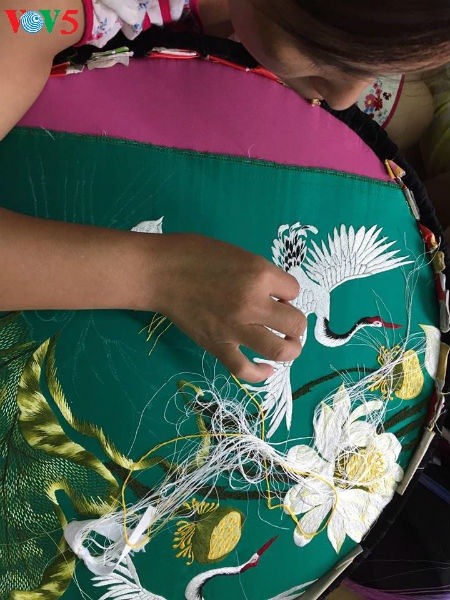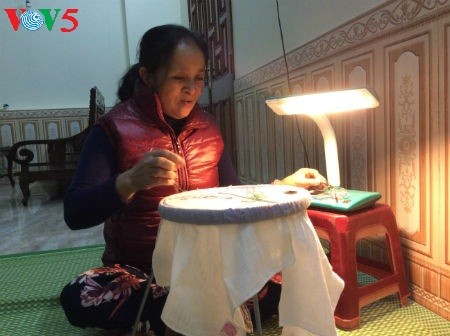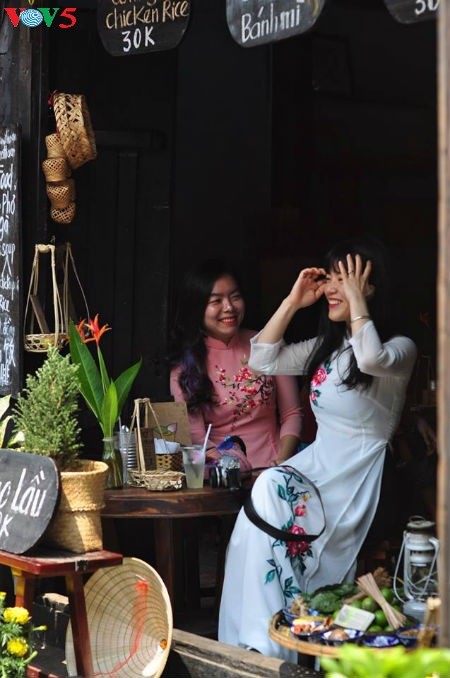(VOVworld) - Located in Thuong Tin district, about 25 kilometers south of Hanoi, Quat Dong embroidery craft village is considered the cradle of embroidery in Vietnam with its brand name famous throughout the northern region and nationwide. Its reputation has remained strong since the 17th century.
 |
Quat Dong embroiderers have created lively pictures from shining embroidery threads.
(Photo: Mai Lan/VOV) |
Going along the former National Highway 1A about 25 kilometers south of Hanoi, it’s easy to recognize the first roadside signs of Quat Dong embroidery craft village – window shops displaying artistic embroidery.
Quat Dong embroidery craft village in Quat Dong Commune, Thuong Tin District, is the homeland of Vietnam’s traditional hand embroidery.
For centuries, Quat Dong has retained the traditional features of northern villages. Under the old banyan tree at the beginning of the village is a shrine worshipping the village god, next to which is a temple dedicated to Le Cong Hanh who was honored as the master of Vietnamese embroidery.
The epitaph in the temple says Dr. Le Cong Hanh, whose real name was Bui Cong Hanh, a native of Quat Dong village, lived in the late Tran Dynasty and early Le Dynasty in the 14th century.
Hanh traveled to China as King Le Chan Tong’s envoy and learned a new embroidery technique. Upon returning to Vietnam, he taught the technique to the villagers of Quat Dong.
After the 17th century, Quat Dong embroidery spread nationwide, making Hanh the master of Vietnamese embroidery.
Phung Van Hung, a village elder, told us: “The temple in honor of the village’s embroidery master was built more than 200 years ago. Many precious objects are kept there including steles and an ancient incense burner. The 12th day of the sixth lunar month every year is observed as the death anniversary of master Le Cong Hanh, when villagers and people from other embroidery villages nationwide offer incense in commemoration of the craft’s master.”
Quat Dong village elders remember when the embroidery was really thriving and Quat Dong products were renowned across Vietnam. Bui Thi Hanh, a veteran embroiderer, says Quat Dong villagers are still attached to the traditional craft.
Hanh recalled: “I began to learn embroidery when I was only 8 years old. The children in the village are taught to embroider at the age of 7 or 8. In that way we have preserved the ancestors’ profession. In the past, we made only two kinds of products: silver lame embroideries and stumpwork, but the younger generation are much better than us.”
 |
| Artisan Nguyen Thi Hong by her embroidery frame (Photo: To Tuan/VOV5) |
In the 1990s there were many embroidery workshops in Quat Dong. Each had 200 to 500 workers. When Vietnam changed to a market economy, the craft seemed to fade. Today each household has at least two or three people following the craft. The tiny house of Nguyen Thi Hong is full of embroidery pictures.
Sitting beside her embroidery frame, Ms. Hong elaborates: “In the past, I specialized in embroidering bedding and shoe-caps for export to Eastern European countries. Then I switched to embroidering pictures and now traditional long dresses and fashion clothing that require sophisticated skill in every sewing detail. Although now there are many embroiderers in the village, professional qualification is the main point because sometimes there are embroidery pictures which only a few people can do.”
 |
| Many Quat Dong products are much sought after by girls. (Photo: Mai Lan/VOV) |
Quat Dong is famous for landscape embroidery pictures such as banyan trees, river wharfs, and scenic spots like the One Pillar Pagoda, Ngoc Son Temple, Hong Thai Communal House, and Hue Imperial City.
It takes months for embroiderers to complete a picture. Quat Dong has many well-known artisans, including Master Bui Le Kinh, who used to embroider royal garments for King Bao Dai and Queen Nam Phuong. Now the only villager holding the title People’s Artisan is Mr. Thai Van Bon, who is famous for embroidering portraits of state leaders. His embroidery portrait of the Thai King has received international praise.